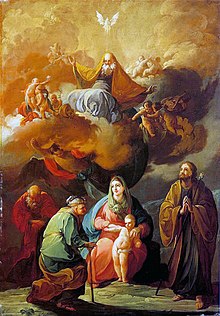
Francisco José de Goya y Lucientes was a Spanish romantic painter and printmaker. He is considered the most important Spanish artist of the late 18th and early 19th centuries. His paintings, drawings, and engravings reflected contemporary historical upheavals and influenced important 19th- and 20th-century painters. Goya is often referred to as the last of the Old Masters and the first of the moderns.

Bartolomé Esteban Murillo was a Spanish Baroque painter. Although he is best known for his religious works, Murillo also produced a considerable number of paintings of contemporary women and children. These lively realistic portraits of flower girls, street urchins, and beggars constitute an extensive and appealing record of the everyday life of his times. He also painted two self-portraits, one in the Frick Collection portraying him in his 30s, and one in London's National Gallery portraying him about 20 years later. In 2017–18, the two museums held an exhibition of them.

The Prado Museum, officially known as Museo Nacional del Prado, is the main Spanish national art museum, located in central Madrid. It houses collections of European art, dating from the 12th century to the early 20th century, based on the former Spanish royal collection, and the single best collection of Spanish art. Founded as a museum of paintings and sculpture in 1819, it also contains important collections of other types of works. The numerous works by Francisco Goya, the single most extensively represented artist, as well as by Hieronymus Bosch, El Greco, Peter Paul Rubens, Titian, and Diego Velázquez, are some of the highlights of the collection. Velázquez and his keen eye and sensibility were also responsible for bringing much of the museum's fine collection of Italian masters to Spain, now one of the largest outside of Italy.

The Alte Pinakothek is an art museum located in the Kunstareal area in Munich, Germany. It is one of the oldest galleries in the world and houses a significant collection of Old Master paintings. The name Alte (Old) Pinakothek refers to the time period covered by the collection—from the fourteenth to the eighteenth century. The Neue Pinakothek, re-built in 1981, covers nineteenth-century art, and Pinakothek der Moderne, opened in 2002, exhibits modern art. All three galleries are part of the Bavarian State Painting Collections, an organization of the Free state of Bavaria.

Fuendetodos is a town in the Campo de Belchite comarca (county), in Aragon, Spain, located about 44 kilometers south-east of Zaragoza. As of 2011, it had a population of approximately 178.

The Naked Maja or The Nude Maja is an oil-on-canvas painting made around 1797–1800 by the Spanish artist Francisco de Goya, and is now in the Museo del Prado in Madrid. It portrays a nude woman reclining on a bed of pillows, and was probably commissioned by Manuel de Godoy, to hang in his private collection in a separate cabinet reserved for nude paintings. Goya created a pendant of the same woman identically posed, but clothed, known today as La maja vestida, also in the Prado, and usually hung next to La maja desnuda. The subject is identified as a maja or fashionable lower-class Madrid woman, based on her costume in La maja vestida.

The Second of May 1808, by Goya, also known as The Charge of the Mamelukes, is a painting by the Spanish painter Francisco Goya. It is a companion to the painting The Third of May 1808 and is set in the Calle de Alcalá near Puerta del Sol, Madrid, during the Dos de Mayo Uprising. It depicts one of the many people's rebellions against the French occupation of Spain that sparked the Peninsular War.
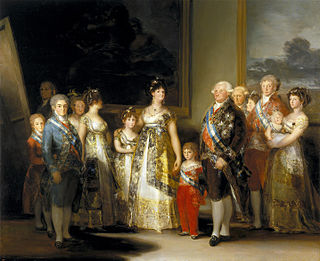
Charles IV of Spain and His Family is an oil-on-canvas group portrait painting by the Spanish artist Francisco Goya. He began work on the painting in 1800, shortly after he became First Chamber Painter to the royal family, and completed it in the summer of 1801.
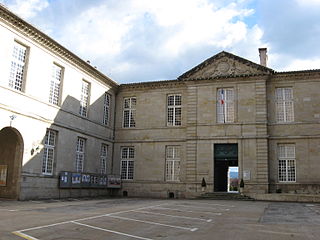
The Goya Museum is an art museum located in Castres, France. The museum was originally established in 1840 and was named after the Spanish painter Francisco Goya since it specialised in hispanic art from 1947.

The Junta of the Philippines, or Sessions of the Junta of the Royal Company of the Philippines is an oil-on-canvas painting, c. 1815, by the Spanish artist Francisco Goya held by the Goya Museum located in Castres.
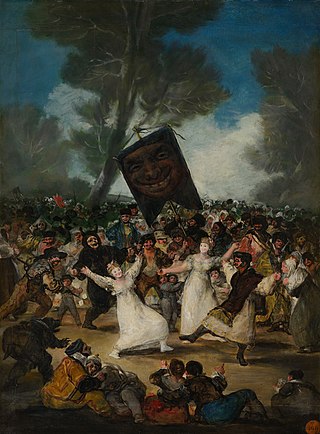
The Burial of the Sardine is an oil-on-panel painting by Spanish artist Francisco Goya, usually dated to the 1810s. The title is posthumous, referring to the culminating event, Entierro de la Sardina, of a three-day carnival in Madrid ending on Ash Wednesday. Masked and disguised revellers are seen dancing their way to the banks of the Manzanares, where a ceremonial sardine will be buried. Goya does not illustrate the fish in the painting, nor the large doll made of straw, called a pelele, from which it hung; the centrepiece is the darkly grinning "King of the Carnival".

Two Old Men, also known as Two Monks or An Old Man and a Monk, are names given to one of the 14 Black Paintings painted by Francisco Goya between 1819-23. At the time Goya was in his mid-seventies and was undergoing a great amount of physical and mental stress after two bouts of an unidentified illness. The works were rendered directly onto the interior walls of the house known as Quinta del Sordo, which Goya purchased in 1819.

The Frescoes in the Cartuja de Aula Dei (1774) are a cycle of frescoes or mural paintings on the Life of the Virgin by Francisco de Goya, realised in secco, in the church of the Charterhouse of Aula Dei near Peñaflor de Gállego on the outskirts of Zaragoza, Aragon, Spain.

The Adoration of the Name of God or The Glory (1772) is a fresco painted by Francisco Goya on the ceiling of the cupola over the Small Choir of the Virgin in the Basílica de Nuestra Señora del Pilar in Zaragoza.
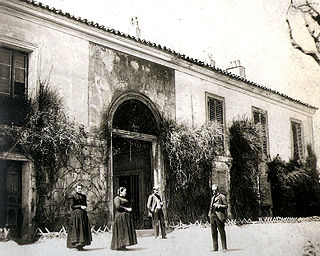
The Black Paintings is the name given to a group of 14 paintings by Francisco Goya from the later years of his life, likely between 1819 and 1823. They portray intense, haunting themes, reflective of both his fear of insanity and his bleak outlook on humanity. In 1819, at the age of 72, Goya moved into a two-story house outside Madrid that was called Quinta del Sordo. Although the house had been named after the previous owner, who was deaf, Goya too was nearly deaf at the time as a result of an unknown illness he had suffered when he was 46. The paintings originally were painted as murals on the walls of the house, later being "hacked off" the walls and attached to canvas by owner Baron Frédéric Émile d'Erlanger. They are now in the Museo del Prado in Madrid.
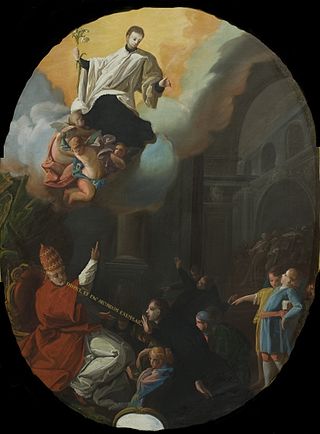
The Consecration of Aloysius Gonzaga as patron saint of youth is a c. 1763 painting attributed to Francisco de Goya and now owned by the town of Jaraba but stored in the Saragossa Museum in Saragossa.
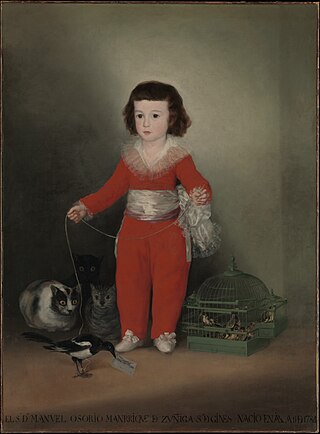
Manuel Osorio Manrique de Zúñiga is a large full-length portrait in oil painted in 1787–88 by the Spanish artist Francisco Goya. It depicts a boy three or four years of age, standing in red clothes, with birds and cats. It is also known as Goya's "Red Boy". It was described by art historian Claus Virch in 1967 as "one of the most appealing and successful portraits of children ever painted, and also one of the most famous". The painting has been held by the Metropolitan Museum of Art in New York since 1949.
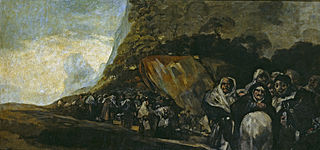
Pilgrimage to the Fountain of San Isidro or The Holy Office are names given to an oil mural by the Spanish artist Francisco Goya (1746–1828), probably completed between 1821 and 1823. The mural is one of the fourteen Black Paintings that Goya applied in oil on the plaster walls of his house. Between 1874 and 1878 the paintings were transferred to canvas supports under the direction of the art restorer of the Museo del Prado, Salvador Martinez Cubells.

Portrait of Don Ramón Satué is an 1823 oil on panel painting by the Spanish artist Francisco de Goya in the collection of the Rijksmuseum, in Amsterdam. It is the only publicly held Goya in the Netherlands.

Saint Bernard of Clairvaux curing a cripple is an oil on canvas painting by Spanish artist Francisco Goya, created in 1787, now held at the Royal Monastery of Saint Joachim and Saint Anne of Valladolid. The picture is markedly Academicist and does not follow the prevalent Romanticism of Goya's work. Francisco de Zurbarán and Francesco Sabatini have been mentioned as influences on its creation.
